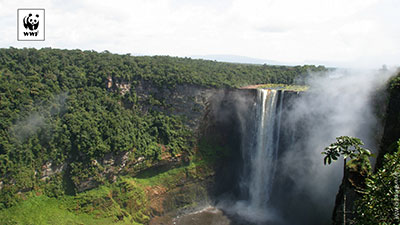Rethinking and retooling our economy for the 21st century.
By WWF Guianas Staff
Recent and not so recent events open the question of the way forward for Guyana’s economy. The traditional major employer, sugar, continues to suffer huge deficits; the forest sector is not as open to foreign direct investment as it would seem, given national and international concerns about the export of unprocessed and uncertified logs and lumber (Barama recently walked away from 1.6 million hectares of timber concessions, announcing it wasn’t profitable).
Green Guyana provides a mean to address the current economic challenges, and an opportunity to ensure an economic future that we have more control of because it benefits from our strategic advantages in a changing world. Green Guyana can provide the impetus to pivot from commodities that are subject to international price fluctuations, like sugar- to branded, high-value green products that serve regional or niche markets.
It’s clear that Green Guyana must promote a renewable power supply that includes a diverse mix of solar, hydro, wind and biofuels (including energy conservation) to reduce the cost of our power supply and spur our manufacturing and transportation sectors. Likewise we can all agree it makes sense to bring more efficiency and responsible environmental stewardship to our mining industries. We believe Green Guyana can also help us address the challenges in traditional sectors like sugar and timber. And we want to suggest a few other elements…
Guyana’s 18.5 million hectares of forest are a world-class carbon storage resource (6.6 billion tons of carbon, or 8,800 tons/capita – the second highest rate in the world) that can be monetized through ecosystem service payments like REDD+ under the Guyana Norway Agreement (GNA). The previous GNA was already delivering significantly more benefits from our forests (US $45 million annually) than the timber industry. And REDD+ is just the first of many benefits which should accrue to Guyana for our outsized role in limiting climate change, producing freshwater and maintaining globally important ecological processes, ecosystems, and biodiversity.
To make the highest use of our standing forests, we must negotiate a new multi-year REDD+ agreement with Norway, while we continue to derive economic benefits from the forest that benefits Guyanese – including low impact logging for local markets and value added products, non-timber forest products like nibbi, crabwood oil, balata and brazil nuts – and nature-based tourism. We should also look for opportunities to develop the economic value of our abundant freshwater resources.
The current struggles of unprofitable sugar provides us with a great opportunity to retool to climate smart agriculture. Instead of trying to encourage industrial agriculture (and more commodities) in the highly biodiverse but poor soils of the Rupununi, we have the chance to focus on increasing the productivity of Guyana’s best agricultural lands – our sugar estates – by diversifying and producing more valuable ‘climate-smart’ crops – brackish water aquaculture, like shrimp, in coastal areas subject to tidal flooding and paku and armored catfish and in the backdam.
Whole Foods Markets in Washington DC are selling farm-raised Arapaima steaks from Peru for $12/lb. We have a remarkable resource along the coast with our networks of water conservancies, canals and kokers that could be producing a whole new range of products and high value vegetables for domestic, Caribbean and niche North American markets. This will also mean the opportunity to replace jobs lost in sugar with these higher value agricultural pursuits. And limit agricultural development to already human impacted lands, as the Green Guyana suggests.
We are not just thinking about production and agriculture.
Another area we should focus on implementing is that of expanding our Protected Area Network and use it to spur the growth of our nature-based tourism industry. It will also help us brand and market Green Guyana specialty products.
Moreover, the idea of benefiting from the nature that surrounds us in a sustainable way must also be sustained and matched with a focused ecosystem restoration practice.
Especially since this also has the potential of becoming a new leading industry, that could help replace timber jobs – experiment and devise means to restore forest on tens of thousand of hectares of old mine (gold, bauxite and others) sites that sit barren in order to combat forest loss and increase REDD+ payments.
To us putting Green Guyana into practice can create thousands of new jobs in mine restoration, reforestation, sustainable aquaculture and agriculture, and nature-based tourism to replace those lost in sugar and timber. Most importantly, Green Guyana should also provide the means to prepare Guyanese to contribute, participate in and benefit from green development with training, education, and skills development.



.jpg)








